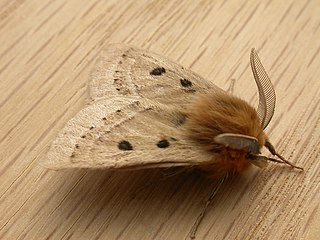
The pasture day moth is a species in the moth family Noctuidae which is active during the day, as its common name implies, making it unlike most other noctuid species. It is found in most southern areas of Australia, ranging from lower Queensland to Tasmania. The species was first described by George French Angas in 1847. It is the only species in the monotypic genus Apina, erected by Francis Walker in 1855.
Aclytia is a genus of tiger moths in the family Erebidae. The genus was erected by Jacob Hübner in 1819.

Thalaina clara, or Clara's satin moth, is a moth of the family Geometridae. The species was first described by Francis Walker in 1855. It is endemic to south-eastern Australia.

Anthela ocellata, the eyespot anthelid, is a moth of the family Anthelidae. The species was first described by Francis Walker in 1855. It is found in Australia, from Bundaberg to Hobart along the east coast.

Anthela varia, the variable anthelid, is a moth of the family Anthelidae. The species was first described by Francis Walker in 1855. It is found in the coastal areas of southern Western Australia, southern Queensland, New South Wales, and Victoria.

Euproctis marginalis, the margined browntail moth, is a moth of the family Erebidae. The species was first described by Francis Walker in 1855. It is found in Australia, including Tasmania.

Sorama bicolor, the two-coloured notodontid, is a moth of the family Notodontidae first described by Francis Walker in 1855. It is found in Australia.

Pinara divisa, the common pinara, is a species of moth of the family Lasiocampidae. It was first described by Francis Walker in 1855. It is found in the south-east quarter of Australia.

Pinara cana, the neat pinara, is a species of moth of the family Lasiocampidae first described by Francis Walker in 1855. It is found in the south-east quarter of Australia.

Doratifera pinguis, the pale cup moth or sometimes the painted cup moth is a moth of the family Limacodidae. The species was first described by Francis Walker in 1855. It is found over the whole eastern seaboard of Australia.
Icta is a genus of moths in the subfamily Lymantriinae. The genus was erected by Francis Walker in 1855. Both species are found in Australia.

Iropoca is a monotypic moth genus in the subfamily Lymantriinae erected by Alfred Jefferis Turner in 1904. Its only species, Iropoca rotundata, the iropoca moth, was first described by Francis Walker in 1855. It is found in the Australian states of Victoria, New South Wales and Queensland.
Lacida is a genus of tussock moths in the family Erebidae. The genus was erected by Francis Walker in 1855.

Euwallengrenia is a genus of moths in the family Lasiocampidae. It was described by David Stephen Fletcher in 1968.

Flindersia maculosa, commonly known as leopardwood or leopard tree, is a species of tree in the family Rutaceae and is endemic to inland areas of eastern Australia. It has mottled bark, simple leaves arranged in opposite pairs, white to cream-coloured flowers and fruit studded with rough points.

Porela vetusta, the ancient porela, is a moth of the family Lasiocampidae. It was first described by Francis Walker in 1855. It is found in the Australian states of New South Wales, Queensland, Tasmania and Victoria.

Porela subfasciata, the fasciated porela, is a species of moth of the family Lasiocampidae. It was first described by (Francis Walker in 1855 and is known from the Australian states of Tasmania and Victoria.

Trilocha varians, the Greenish silk-moth is a moth in the family Bombycidae described by Francis Walker in 1855. It is widespread in the Oriental region from India, Sri Lanka, China, extending to Taiwan, the Philippines, Pakistan, Sulawesi and Java.

Euthrix laeta is a moth of the family Lasiocampidae first described by Francis Walker in 1855.


















